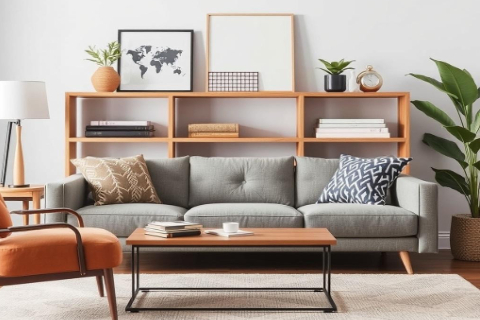When you set out to create a cozy and stylish living space, have you noticed how easy it is to overlook the “small stuff”? You know, the furniture pieces that don’t exactly steal the spotlight but somehow complete the room? I’m talking about secondary furniture—the supporting cast to your sofa, dining table, or bed. Trust me, I used to ignore them, too, thinking that as long as I had the “big ticket items,” I was good to go. Spoiler alert: I wasn’t.
Secondary furniture matters more than you think. It’s what takes your space from “functional” to “freakin’ personal.” And if you’re like me—a sucker for sustainability and design—choosing the right secondary pieces can feel like threading a needle. But don’t worry, I’ve got you covered.
This post isn’t about selling you stuff. It’s about helping you curate. Together, we’ll break down what makes a secondary furniture group, talk sustainability (because you can stylishly save the planet), and spark ideas for adding pieces that reflect your vibe and elevate your space.
Defining Secondary Furniture
First off, what even is secondary furniture? Think of it this way—if your sofa is the star of your living room, then your coffee table, side tables, and ottomans are the supporting actors. They don’t scream for attention, but you’d notice if they weren’t there.
Secondary furniture is all about function, balance, and (here’s the fun part) personality. These pieces help fill the gaps and make your space liveable without adding clutter. Chairs, benches, bar carts, accent tables—this is where you can play.
And the best part? Secondary furniture doesn’t always need to match your “main event” pieces. Okay, I’ve said it. You don’t need to buy that painfully matchy-matchy coffee table set just because it came with your sofa. Mix. It. Up.
Examples of Common Secondary Furniture Pieces
Living Room: Armchairs, side tables, footstools, console tables, bookcases.
Bedroom: Nightstands, benches, small bedside tables or chairs.
Dining Area: Bar carts, buffets, floating shelves.
Entryway: Shoe racks, storage benches, coat stands.
These aren’t just space fillers; they’re functional pieces that make day-to-day living easier. Do you not have a side table when holding your morning coffee? I’ve been there. It’s a struggle I wouldn’t wish on anyone.
Why Secondary Furniture is Underrated
Here’s a little honesty for you—it took me years to realize why my living spaces always felt “unfinished.” I was fixated on sofas, beds, and dining tables, forgetting that these aren’t the only pieces people interact with. Secondary furniture brings layers, both physically and visually.
Here’s how it works:
Functionality: They’re where you store, rest, or place stuff—like the coffee table you’re probably leaning on.
Flow: Secondary furniture helps the room “breathe.” You can fill awkward gaps and make everything feel intentional.
Style: This is where you get to inject some flair. Why settle for generic when you can add some “you-ness” to your space?
It’s like accessorizing but with furniture. You wouldn’t wear just a plain T-shirt and jeans to a party. The same goes for designing your home.
How to Choose Sustainable Secondary Furniture
Here’s where I get a little preachy (but in a good way, I promise). Secondary furniture is a golden opportunity to live out your values, especially if you care about sustainability. Don’t think of this as restricting—it’s empowering.
How? Start here:
Shop Secondhand
I’ll shout it from the rooftops—vintage shops, online marketplaces, and thrift stores are bursting with hidden gems. Yes, it takes time. But you can snag a timeless, sturdy piece for a fraction of the cost of something mass-produced—bonus points for eco-friendliness.
Prioritize Materials
Look for furniture made from sustainable materials like reclaimed wood, bamboo, or recycled metals. Avoid particleboards or cheap plastics when possible—they tend to crumble fast and go straight to landfills.
Think Longevity, Not Trends
Remember when trendy “mid-century everything” pieces were all the rage? Classic and neutral pieces in good condition will always outlast fleeting trends (and headaches). Go timeless before trendy.
DIY or Upcycle
There’s something oddly satisfying about rescuing an old piece of furniture and giving it new life. Paint an old chair bold yellow, add new hardware to a worn dresser, reupholster that weird-patterned ottoman. It takes some effort, sure, but it’s art—your art.
Support Small Makers
When you can, buy from smaller, local furniture makers focusing on sustainable practices. Not only do you get a unique piece, but you’re also pushing back against massive, waste-producing brands.
How To Style Secondary Furniture
Okay, so you’ve nailed the what. Now, here’s how to pull it all together.
Play With Heights
Try using furniture pieces at varying heights for visual interest. Pair a low coffee table with tall side lamps, or place an oversized mirror above a short console table. It creates movement and makes the room feel intentional.
Mix Textures
Contrast sleek and smooth surfaces (like glass tables) with softer, textured materials (like a rattan chair). Mixing adds depth to an otherwise dull space.
Layer Rugs and Accessories
A rug adds warmth, coziness, and a border to ground secondary furniture. Pair that ottoman with a stylish tray—Chef’s Kiss.
Don’t Forget Lighting
Floor lamps and table lamps are your best friends. Lighting is functional, but it also adds cozy vibes that overhead lighting can’t.
Seasonal Switches
Flex your creative muscles by rotating decor on secondary furniture seasonally. Example? Add a plaid throw on your entry bench during fall or fresh flowers on that console in spring.
Make Your Space Work For You
When it comes down to it, secondary furniture pieces are more than just “extras.” They’re the understated heroes keeping your space functional, stylish, and uniquely you.
The more I leaned into the whole “design intentionality” thing, the more joy I found in these smaller pieces. Side tables, storage shelves, accent chairs—they’ve transformed my living space into one I genuinely love returning to.
Lastly, take your time. Feel those indecisive feelings. The right secondary furniture doesn’t just fill your space with stuff—it leaves room for the life you want to live.











